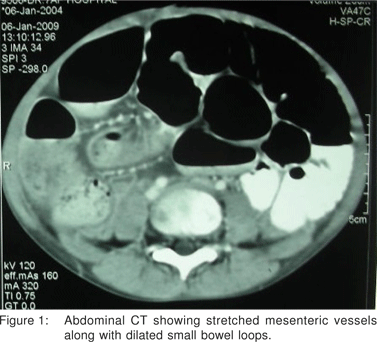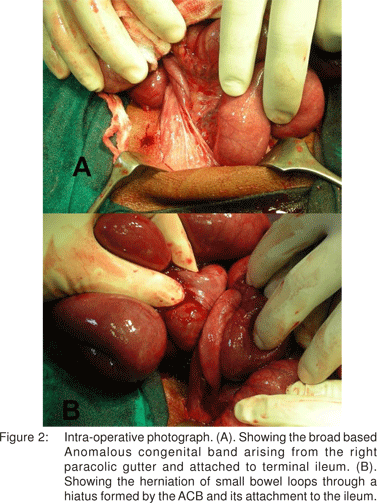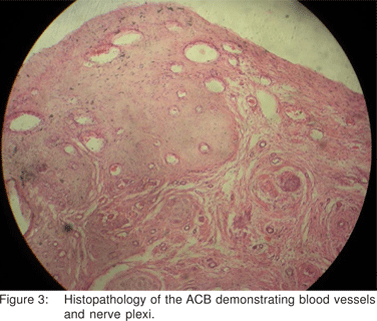48uep6bbphidvals|346
48uep6bbph|2000F98CTab_Articles|Fulltext
Intestinal obstruction is the commonest surgical emergency encountered in childhood.[1] Intestinal obstruction caused by an anomalous congenital band (ACB) is extremely rare.[2] We report a case of intestinal obstruction in a child due to internal herniation caused by an anomalous congenital band. To the best of our knowledge, this is only the second such case to be reported in literature.
Case Report
A 5 year old male child was brought to our emergency department with a history of pain abdomen, vomiting and abdominal distention of 5 days duration. He was being managed conservatively at another hospital for the same. He had constipation but was passing flatus occasionally and had no history of fever. He had a history of intestinal obstruction one year prior to the present episode when he was operated elsewhere. However, no relevant documents were available for perusal. He had then been put on anti-tubercular drugs which were discontinued by the parents after a few days on their own.
On examination, the child was afebrile, had tachycardia and was mildly dehydrated. The abdominal examination showed a well healed paramedian scar of previous surgery and no incisional hernia. The abdomen was distended but non-tender. No mass or free fluid was appreciated and bowel sounds were sluggish. Rectal examination revealed an empty rectum.
Laboratory investigations revealed leukocytosis (11400 cells/cu. mm) and normal electrolytes levels. Erect and supine abdominal radiographs demonstrated dilated small bowel loops and ultrasound of abdomen showed dilated fluid filled bowel loops with minimal ascites. A CT scan of abdomen also demonstrated dilated small bowel loops with stretched mesenteric vessels particularly at the attachment of mesentery at the ileo-caecal junction suggesting an internal herniation (Figure 1).
On laparotomy, there were minimal adhesions along with a small quantity of free fluid and no evidence of tuberculosis or malrotation. The small bowel was grossly dilated and when they were followed towards the ileo-caecal junction, the loops were found herniating through a hiatus formed by the ACB and its attachment to the ileum. The band was running from the right paracolic gutter and right lobe of liver to the antimesenteric border of the terminal ileum (Figure 2). The band was divided between ligatures to release the herniated loops of intestine. The site of attachment of the ACB to the terminal ileum was strictured and had to be resected. The child made an uneventful post op recovery. Histopathology of the band revealed blood vessels and nerves consistent with an ACB (Figure 3) and the resected ileum was unremarkable except for atrophic changes in the muscularis propria in the dilated portion.



Discussion
The most common etiology of small bowel obstruction is adhesions followed by inguinal hernias, tumours, intussusception, foreign bodies and inflammatory bowel disease.[2] Tuberculosis is incriminated in a sizeable proportion of cases in this part of the world.[3] However, amongst the pediatric population, in the post neonatal age group, the more common causes are intussusception, incarcerated hernias, malrotation with midgut volvulus and post-operative adhesions.[4] Of all the causes less than 1% of cases have been a scribed to internal hernias and predisposing factors are congenital bands, congenital anomalies of the intestinal rotation and congenital defects in the mesentery or omentum, postsurgical or traumatic defects of the mesentery and omentum.[5,6]
ACBs causing intestinal obstruction are very rare and to the best of our knowledge only one case of internal hernias caused by an anomalous congenital band has been reported in literature previously.[7]
An ACB is one which has no identifiable embryological or acquired basis.[8] During embryogenesis, abnormal adhesion of the peritoneal folds can induce congenital bands as anomalies of the mesentery that can cause intestinal obstruction and their location is different from that of the well-known embryogenic remnants such as vitelline vessels or omphalomesenteric ducts.[8] Such bands cause obstruction by entrapment of the intestine between the band and mesentery or by compression of the bowel.[8] However, it is possible that these bands lead to an internal herniation as in our case. The broad based band, running from the right paracolic gutter and right lobe of liver to the anti-mesenteric border of terminal ileum formed a bridge underneath which the small bowel loops had herniated in addition to causing compression at its site of attachment. There are reports of a similar presentation caused by the adhesion of the tip of Meckel’s diverticulum to the adjacent mesentery and or an inflamed appendix epiploca and greater omentum.[9,10]
Though the patient had a previous surgery for similar complaints and was started on anti tubercular therapy (discontinued by the parents after a couple of days), we believe that this is an ACB rather than an inflammatory band. This is explained by the absence of evidence of tuberculosis either current or past in the peritoneal cavity, the location and attachment of the band and further supported by the histopathological findings where in blood vessels and nerve plexi were seen.8
Though the diagnosis of intestinal obstruction is straight forward with the typical presentation and clinical findings aided by imaging studies, the cause of obstruction may be difficult to establish pre-operatively despite the availability of modern imaging techniques. A barium study may point towards a congenital band as an etiology. An abdominal CT is a very useful modality to pick up an internal hernia as was in our case but bands are usually identified on exploratory laparotomy. With the advent of minimal access surgery, diagnostic laparoscopy may be a safe and feasible modality to diagnose congenital bands and also to deliver definitive treatment.[11] In our case, in view of grossly distended bowel loops and a prior history of abdominal tuberculosis and laparotomy, a diagnostic laparoscopy was not considered.
Surgery is the cornerstone in the management of ACB causing obstruction. This can be accomplished through an exploratory laparotomy with division of the band which would release the trapped bowel and resection of non-viable bowel if any. A quick decision to proceed to surgery is vital to prevent strangulation of bowel and to reduce the morbidity and mortality associated with it. As brought out earlier, laparoscopy is increasingly being used in the definitive management of such cases and would offer patients maximum benefit with minimum risk.[11]
References
1. Rao PL, Sharma AK, Yadav K, Mitra SK, Pathak IC. Acute intestinal obstruction in children as seen in north west India. Indian Pediatr. 1978;15:1017–23.
2. Dimitrios C, George AA, Dimosthenis Z, Nikolaos X. Intestinal obstruction due to an anomalous congenital band. Saudi J Gastroenterol. 2008;14:36–7.
3. Khanzada TW, Samad A, Sushel C. Etiological spectrum of dynamic intestinal obstruction. Gomal J Med Sci. 2007;5:59–61.
4. Parashar UD, Holman RC, Cummings KC, Staggs NW, Curns AT, Zimmerman CM, et al. Trends in intussusceptions-associated hospitalizations and deaths among US infants. Pediatrics. 2000;106:1413–21.
5. Balthazar EJ, Birnbaum BA, Megibow AJ, Gordon RB, Whelan CA, Hulnick DH. Closed-loop and strangulating obstruction: CT signs. Radiology. 1992;185:769–75.
6. Ozenç A, Ozdemir A, Coskun T. Internal hernia in adults. Int Surg. 1998;83:167–70.
7. Sung TJ, Cho JW. Small bowel obstruction caused by an anomalous congenital band in an infant. Korean J Pediatr. 2008;51:219–21.
8. Akgur FM, Tanyel FC, Buyukpamukcu N, Hicsonmez A. Anomalous congenital bands causing intestinal obstruction in children. J Pediatr Surg. 1992;27:471–3.
9. Ko SF, Tiao MM, Huang FC, Hsieh CS, Huang CC, Ng SH, et al. Internal hernia associated with Meckel’s diverticulum in 2 pediatric patients. Am J Emerg Med. 2008;26:86–90.
10. Kulacoglu H, Tumer H, Aktimur R, Kusdemir A. Internal Herniation with fatal outcome: herniation through an unusual apertura between epiploic appendices and greater omentum. Acta Chir Belg. 2006;106:109–111.
11. Wu JM, Lin HF, Chen KH, Tseng LM, Huang SH. Laparoscopic diagnosis and treatment of acute small bowel obstruction resulting from a congenital band. Surg Laparosc Endosc Percutan Tech. 2005;15:294–6.